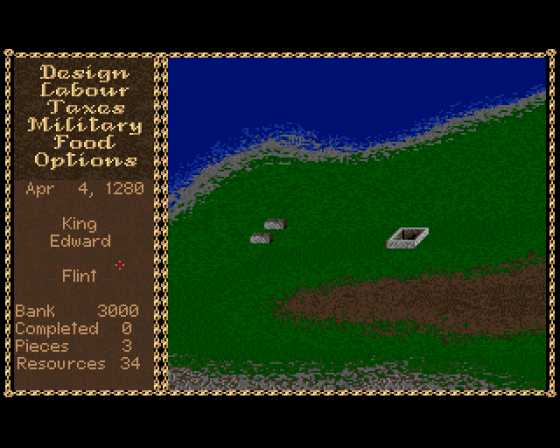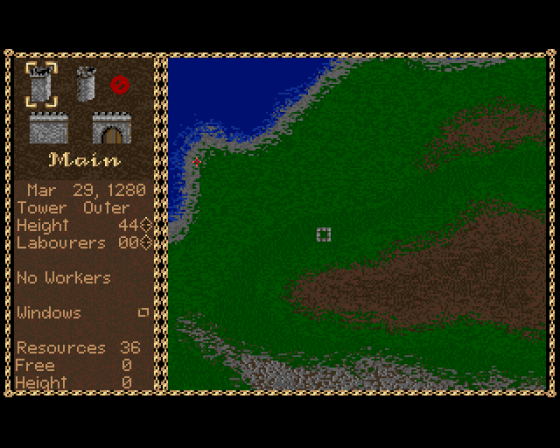
Amiga Power
 1st May 1992
1st May 1992
Castles
So we've had (or are about to have) city sims, global sims, even ant colony sims. Winding the clock back 700 years or so for an Englishman's-home sim seems like such an obvious idea it's a wonder nobody thought of it a long time ago. Imagine it, designing your own medieval stronghold, lording it over the peasants, covering attackers in boiling oil. Ah, the life of an oppressive, sadistic, peasant-bashing feudal baron's the one for me...
Well, Interplay did think of it a while back, as Castles has been around on the PC for some months now. Now out on the Amiga, it offers the challenge of ruling a kingdom and building and defending your own stone castles. The simulation model is based on the castles built by King Edward I (reigned 1272-1307) to consolidate the kingdom's hold on those wild celtic devolutionists, the Welsh.
I say, 'based on' - the 'real world' scenario is of a fictionalised medieval Albion, packed with all kinds of dubious characters who carry a sort of sub-plot to the main exercise of castle building in an attempt to give the otherwise mundane stone-stacking a storyline. And for those with weirder or wilder tastes, there's a fantasy world option featuring dragons, trolls and wizards too.

So how does it work? Well, to start with you can build either a single castle or conduct a campaign to subjugate the celts by building a series of eight. While you're doing this, other factors are thrown into the pot such as attacks by berserk celts, knights popping up to report on distant battles, annoying bishops hassling you for a game of chess - the usual petty trials of castle ownership. At least there's a dungeon handy for double glazing salesmen.
So, to building. Four levels of play are offered, each of which presents a different scale of resources. Such considerations as the convenience of local stone quarries; how much money you can raise through taxation; and the availability of labour serve to give the impression that building a castle takes a good deal more thought than knocking up a garden shed.
The main screen shows the local terrain and it's up to you to decide whereabouts to build. You can't go building on rock, in forests (very ecological I'm sure) or, for obvious reasons, in a swamp. The best option here is to look and see if there's a convenient body of water handy, and, if there is, to build near it, thus limiting the number of directions from which an enemy can approach.

Next, it's time to lay out the foundations. There are two types of tower to choose from - square and the more difficult to undermine round tower - plus the facility to specify height and whether or not to have windows. To plan out your castle, you select the appropriate tower and paste it on the map several times to form the outline of whatever shape you want. Be careful though. If you get carried away and start mapping out a small city, your resources will rapidly dwindle, leaving no scope left for those most useful of defensive devices, walls.
Wall segments come in thicknesses of nine or twelve feet and, again, their heights can be specified. You can also include arrow slits and cauldrons (simmer oil at gas mark 6 for three hours), just to make the lives of any aggressors that bit more miserable. Finally, it might be nice to have a gate - getting in and out can be tough without one.
And there we have it. An impressive fortification standing all of about four-feet high. Not too good at keeping out the draughts really, so it's off to the Labour menu to hire some workers to build it up a bit. The size of the workforce depends on how much dosh you're raising from taxation (egad, sir, you mean to pay them?) - fork out too much on wages that they'll all bog off when the money runs out. You can allocate work teams to parts of the castle, then sit back and watch as the little figures on-screen slowly start to build it up. And boy, is it ever slow! Things get really tedious as wall sections and towers gradually take shape, but - presumably in a bid to keep you awake - attacking bands of utterly anti-social types come wandering along regularly.
Under Attack: Medieval Dead

Suddenly, you're thrust into battle. The workforce has run off and the marauders come and knock down everything they've built. Damn, I knew that Military menu was there for a reason. You can hire an army of foot soldiers and archers, the size of which depends on how many components there are to your castle. Of course, they'll need paying and training, so there's yet more financial juggling to take care of. In battle, your faithful fighting units (a maximum of 20) are deployed in the same way as castle components are placed and, once given a target to attack, pretty well conduct the fight themselves. Hum. Do I really need to be here or would the computer have more fun on its own?
At least there are the visitors to keep me amused while the game plays with itself. In the fantasy scenario, battered and bleeding knights arrive with dark warnings of savage troll armies on the move, and you're presented with a choice of answers: ignore them, send troops or form an alliance with the celts. Decisions made earlier in the game supposedly affect how the story develops, but you know it'll all end up with an army having a go at your castle so you may as well say 'nay' to messengers on the game options screen.
While it all sounds quite jolly, and while the sight of your castle design taking shape is fun, it can get rather boring. The battle scenes are more of an intrusion than an exciting aside, for the simple reason that they're not very dramatic. The pace at which the workers do their thing is somewhat snail-like too, and it's a tedious business having to manually relocate manpower every time a section of the castle is finished - haven't these guys ever heard of initiative?
But my main gripe is that, in trying to offer something a little lighter and more action-orientated, a lot of potential has been over-looked. A greater variety of military units - such as the inclusion of calvalry - would have been nice, and more fortification options should really be there. Sure, you can dig a moat, but that's the only earthwork on offer.
Castles as a sim is not very realistic and as a game verges on the tedious. There are some thrills to be had, but the ease with which an enemy can slight what you've spent hours putting together makes you wonder what the point of building it was in the first place. This is a game with plenty of potential, but too little of it seems to have been realised. I'm sure oppressive, sadistic, peasant-bashing feudal barons used to have much more fun.
The Bottom Line
Uppers: It's rewarding watching your very own castle design going up - much better than Lego as you don't have to clear it all up afterwards. Potentially fun in a Sim City sort of way.
Downers: However, it's less than rewarding watching your own castle design coming down with such ease after you've spent many tedious hours building it.
Castles sounds fun but falls somewhat between two stools. The lack of realism makes it not a very stimulating simulation, and there's not enough going on in the gameplay department. Disappointing, but it's bound to find a few dedicated fans.












